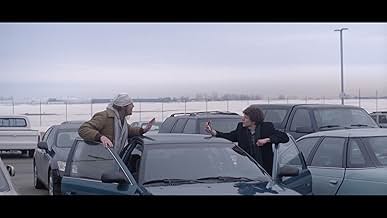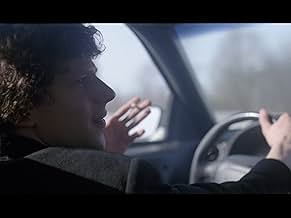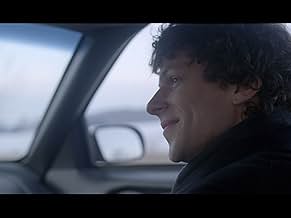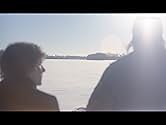The story of the five-day interview between Rolling Stone reporter David Lipsky and acclaimed novelist David Foster Wallace, which took place right after the 1996 publication of Wallace's gr... Read allThe story of the five-day interview between Rolling Stone reporter David Lipsky and acclaimed novelist David Foster Wallace, which took place right after the 1996 publication of Wallace's groundbreaking epic novel, 'Infinite Jest.'The story of the five-day interview between Rolling Stone reporter David Lipsky and acclaimed novelist David Foster Wallace, which took place right after the 1996 publication of Wallace's groundbreaking epic novel, 'Infinite Jest.'
- Director
- Writers
- Stars
- Awards
- 4 wins & 18 nominations total
- Bookstore Patron 2
- (as Jennifer Holman)
- Director
- Writers
- All cast & crew
- Production, box office & more at IMDbPro
Featured reviews
Jason Segel and Jesse Eisenberg live up to the task of interpreting the script, helped along the way by director James Ponsoldt. The direction is simple, and the camera work is relatively basic throughout, giving the actors plenty of room to work with natural rhythm. Segel definitely impressed me, as this was the first dramatic role I've seen him in. While he didn't exactly capture some of Wallace's real-life mannerisms, I'm not sure if that was exactly the point of the film. He interpreted the script in a powerful way, and I think that that ended up working out quite well for the overall tone of the film. Eisenberg played his usual somewhat neurotic, slightly asshole- ish character very well, and I thought it fit the reporter role perfectly.
Overall, I would strongly recommend the film. 9/10
I don't expect everyone to like it to the degree that I did because I can only base my strong inclination towards this movie on the connection I personally made with it which was emotional rather than intellectual, although the film is rich and lingering in its intellect as well, and of course; I recognize what makes this film profound, which I'll try to explain.
This is a talky film from director James Ponsoldt, who I'd now have to rank as one of my favorite contemporary directors after this and another I've seen and loved, The Spectacular Now. This director isn't one you'd normally find on a list ranking among the greatest working today because he's not about style and doesn't appeal to the ego as much as other contemporaries such as Wes Anderson and David Fincher do (in addition to many others, not to single them out). No, Ponsoldt is subtle and reserves his ego. He is unimposing on the lives of his characters and candid about what his films are trying to do and say, not hiding beneath film rhetoric or allegory or the impression of a representational work. And what's great about this is how his films point out that you don't need intricate sets or perfectly symmetrical shots to create beauty. This film has some of the most beautiful shots I've seen (the shot of them walking in the snow, the shot of the normally- withdrawn Wallace dancing), all the more so because of their subtlety, giving the feeling that the beauty was discovered and not created by the director.
But the beauty is often created by the actors. Ponsoldt trusts his actors and puts his efforts towards making the characters come alive before our eyes. I was under the fantastic impression that I was witnessing a completely real human soul with Segel's performance. He felt so real, so three dimensional. I understand him, even though I am not him. This is more magical to me than sweeping camera movements or extravagant art direction.
I didn't realize when watching the film that the dialogue is all based on, if not directly taken from, the tapes journalist (and protagonist) David Lipsky (Eisenberg) recorded of his interviewee, universally acclaimed novelist David Foster Wallace (Segel). The dialogue is rich with insight into the character's thought processes and their observations on life (but mostly those of Wallace). I was riveted at every moment the two were talking, feeling as though being revealed before me were the truths of life. The thrill of being a fly on the wall. And it's not just the words containing the wisdom of the thoughtful and complicated Wallace, but the delivery via the actors and the way in which the many hours of tape are edited to allow Wallace's ideas and observations to resonate. Even beyond Wallace's ideas, the film cuts to the core and observes Wallace as a human being, not different for his brilliance but the same for his humanness.
The film is about so many things it would be overwhelming to attempt list all of them. Its ideas, however many, are all-encompassing of what it means to exist, which is, beyond the desire for fame and ego-boosts, to want to be understood. The film observes how the inner-worlds of all people are so uniquely complicated and pays tribute to that wonder. I'll be relating my experiences to this film in time to come.
In 1996 David Lipsky (Jesse Eisenberg) interviewed acclaimed author David Foster Wallace (Jason Segel) over the course of several days in Minneapolis for a book tour about his 1000 page epic novel, Infinite Jest. Essentially a two hander in the spirit of the recent True Story, about the interview with alleged murderer Christian Longo (James Franco), The End of the Tour is one of the most accessible biopics about smart people in recent memory.
What sets The End off from True Story and other stories about gifted, troubled authors is its easy manner that doesn't play up intellectual snobbery but rather tries to understand the isolation and diffidence of geniuses. While Lipsky is not the genius writer that Wallace is, he is still a published novelist and a writer for Rolling Stone—the boy has the chops that allow him to get inside Wallace, as much as that is possible with writers slightly less private than, say, JD Salinger.
Wallace reveals himself, albeit obliquely, as a talented working class author bedeviled by addictions that seem to feed his insecurities: Obsessed by TV, he decides not to have one because he'd watch it; having overdosed on booze, he decides not to drink; whether or not he became addicted to heroin is uncertain.
What is certain is that as individualistic as Wallace is, and his densely verbose prose would confirm that, he is still one of us just trying to figure out his existential place in a chaotic world. His immersion in pop culture makes the brainy prose readable and enjoyable because he is tuned in and while heavily analytical, in touch with our daily experience.
Such is the spirit of The End of the Tour: it frequently relies on the mundane (e.g., pop tarts for breakfast, McDonald's for dinner, old TV shows for entertainment) to allow the more challenging—why he wears a bandanna—to reveal his soul (he worries that Lipsky's question about the affectation of the bandanna now makes himself conscious about wearing it, as if he were trying for an impression when he actually wasn't). His prose can be downright entertaining: "Because here's something else that's weird but true: in the day-to day trenches of adult life, there is actually no such thing as atheism. There is no such thing as not worshiping. Everybody worships. The only choice we get is what to worship."
Segel is a revelation as an actor. From mediocre romcoms to perfectly embodying a conflicted writer, Segel remains in low-key character throughout. Here's what Wallace says about the loneliness that was his constant companion before he committed suicide:
"Fiction is one of the few experiences where loneliness can be both confronted and relieved. Drugs, movies where stuff blows up, loud parties — all these chase away loneliness by making me forget my name's Dave and I live in a one-by-one box of bone no other party can penetrate or know. Fiction, poetry, music, really deep serious sex, and, in various ways, religion — these are the places (for me) where loneliness is countenanced, stared down, transfigured, treated." (The Pale King, 2011)
Introduce yourself to this verbal magician by seeing one of the best films of the year: The End of the Tour.
Storyline
Did you know
- TriviaThe song heard on the soundtrack when the film ends is "The Big Ship" by Brian Eno, one of David Foster Wallace's favorite songs. It was also used for the climax of Me and Earl and the Dying Girl (2015), another film that premiered at the 2015 Sundance Film Festival.
- GoofsIn regards to the scene where Mrs. Gunderson gives Mr. Wallace and Mr. Lipsky a car tour of Minneapolis sites: The Mary Tyler Moore statue on Nicollet Mall in Minneapolis, was not given to the City by TV Land until 2002. Also, it is not legal for cars to drive down Nicollet Mall.
- Quotes
David Foster Wallace: It may be in the old days what was known as a spiritual crisis: feeling as though every axiom in your life turned out to be false... and there was actually nothing. And that you were nothing. And that it's all a delusion and you're so much better than everybody 'cause you can see how this is just a delusion, and you're so much worse because you can't fucking function.
- Crazy creditsHalfway through the closing credits, there is an extra scene told from the perspective of David Foster Wallace as Lipsky goes to the bathroom to wash out the chewing tobacco. It shows what Wallace did while he was in the bathroom: he speaks privately into the tape recorder.
- How long is The End of the Tour?Powered by Alexa
Details
Box office
- Gross US & Canada
- $3,002,884
- Opening weekend US & Canada
- $123,238
- Aug 2, 2015
- Gross worldwide
- $3,072,991
- Runtime1 hour 46 minutes
- Color
- Sound mix
- Aspect ratio
- 2.35 : 1
Contribute to this page



































